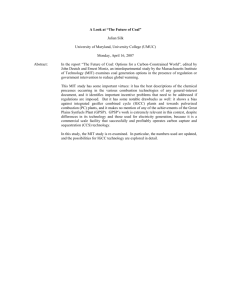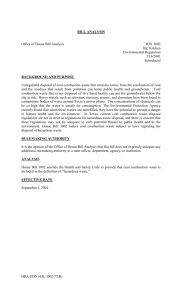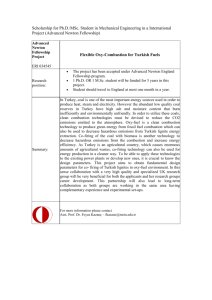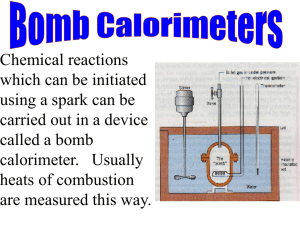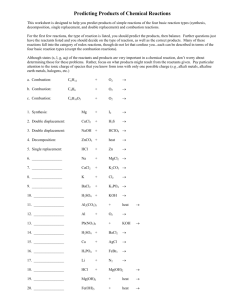The Measurement of Combustion Energies Using a Bomb Calorimeter
advertisement
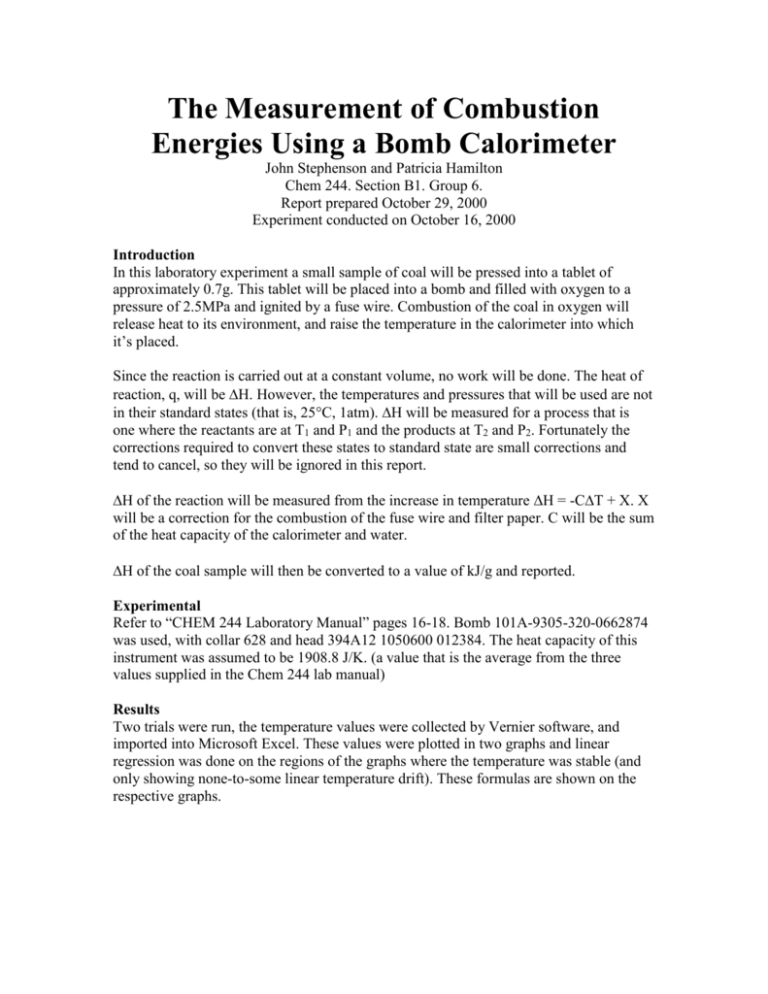
The Measurement of Combustion
Energies Using a Bomb Calorimeter
John Stephenson and Patricia Hamilton
Chem 244. Section B1. Group 6.
Report prepared October 29, 2000
Experiment conducted on October 16, 2000
Introduction
In this laboratory experiment a small sample of coal will be pressed into a tablet of
approximately 0.7g. This tablet will be placed into a bomb and filled with oxygen to a
pressure of 2.5MPa and ignited by a fuse wire. Combustion of the coal in oxygen will
release heat to its environment, and raise the temperature in the calorimeter into which
it’s placed.
Since the reaction is carried out at a constant volume, no work will be done. The heat of
reaction, q, will be H. However, the temperatures and pressures that will be used are not
in their standard states (that is, 25C, 1atm). H will be measured for a process that is
one where the reactants are at T1 and P1 and the products at T2 and P2. Fortunately the
corrections required to convert these states to standard state are small corrections and
tend to cancel, so they will be ignored in this report.
H of the reaction will be measured from the increase in temperature H = -CT + X. X
will be a correction for the combustion of the fuse wire and filter paper. C will be the sum
of the heat capacity of the calorimeter and water.
H of the coal sample will then be converted to a value of kJ/g and reported.
Experimental
Refer to “CHEM 244 Laboratory Manual” pages 16-18. Bomb 101A-9305-320-0662874
was used, with collar 628 and head 394A12 1050600 012384. The heat capacity of this
instrument was assumed to be 1908.8 J/K. (a value that is the average from the three
values supplied in the Chem 244 lab manual)
Results
Two trials were run, the temperature values were collected by Vernier software, and
imported into Microsoft Excel. These values were plotted in two graphs and linear
regression was done on the regions of the graphs where the temperature was stable (and
only showing none-to-some linear temperature drift). These formulas are shown on the
respective graphs.
Table #1
Description
Quantity (Trial 1)
Mass of coal pellet (Coal Sample ‘J’)
0.7224g
Mass of water used in bomb
2000.2g
Mass of filter paper
0.0156g
Length of fuse wire
12.5cm
Length of fuse wire not-oxidized
3.2cm
The filter paper has a heat of combustion of 17230 J/g.
The heat of combustion of the wire is 9.6 J/cm.
Quantity (Trial 2)
0.6974g
2000.4g
0.0230g
11.4cm
1.4cm
Calculation of T1
A time t=7 minutes is chosen such that the area of the curve between the two temperature
linear regression lines is approximately equal..
T1 = T2 - T1
= (25.414) – (0.0063t + 23.441) {t=7, see Graph #1}
= 1.929K
Calculation of T2
A time of t=7 is chosen by the same logic used to calculate T in Trial 1.
T2 = T2 - T1
= (0.0009t+25.114) – (-0.0003t + 23.226) {t=7, see Graph #2}
= 1.896K
Trial 1 H1 Calculation
C is the heat capacity of the instrument (CI) plus the heat capacity of the water (CW).
C = CI + CW
= 1908.8 J/K + (2000.2g) (75.29 J/K.mol) / (18.02g/mol)
= 10265.9 J/K
X is the correction for the combustion of the filter paper and the fuse wire.
X = Xfuse + Xpaper
= (12.5cm-3.2cm)(9.6J/cm) + (0.0156g)(17230J/g)
=358J
H1 = (-CT1 + X)/mpellet
= (-(10265.9 J/K)(1.929 K) + 358J) / (0.7224g)
= -26.91 kJ/g
Trial 1 H2 Calculation
C is the heat capacity of the instrument (CI) plus the heat capacity of the water (CW).
C = CI + CW
= 1908.8 J/K + (2000.4g) (75.29 J/K.mol) / (18.02g/mol)
= 10266.7 J/K
X is the correction for the combustion of the filter paper and the fuse wire.
X = Xfuse + Xpaper
= (11.4cm-1.4cm)(9.6J/cm) + (0.0230g)(17230J/g)
= 492J
H2 = (-CT1 + X)/mpellet
= (-(10266.7 J/K)(1.896 K) + 492J) / (0.6974g)
= -27.21 kJ/g
Discussion
The two values for heats of combustion of coal sample ‘J’ were –26.91 kJ/g and -27.21
kJ/g.
Possible sources of error include measurement error (the actual resolution of the digital
interface to the thermometer appears to be 0.012K even although it appears to report
data to 0.0005K) and choice of time interval, t, to calculate T was only approximate
and not calculated by a numerical integral method. We did not make temperature and
pressure conversions to standard state, and the measurement of the two values H1 and
H2 were made at slightly different temperatures.
Even still, these two values are within 1% of each other, and we are satisfied with these
results.
